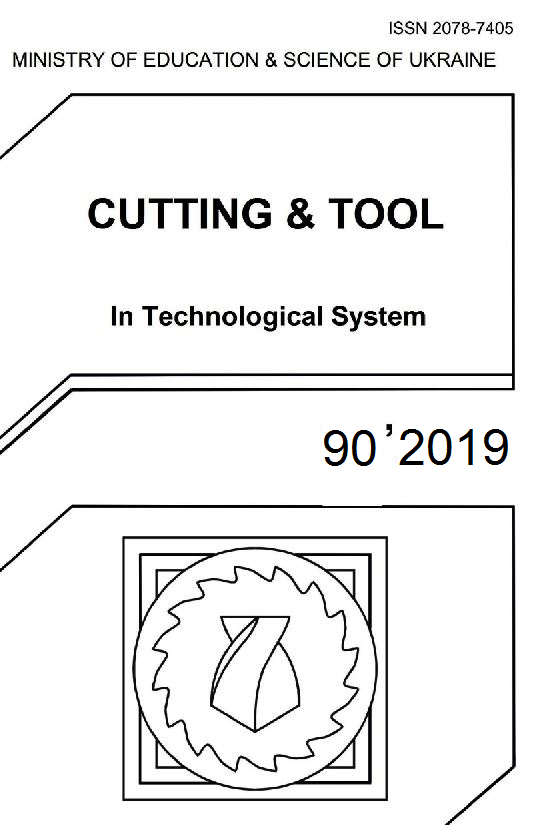MODELING OF THE PROCESS OF VIBRATORY GRINDING BY FINITE ELEMENT METHOD
DOI:
https://doi.org/10.20998/2078-7405.2019.90.14Keywords:
polycrystalline superhard materials, diamond grains of a circle, ligament of a circle, self-sharpening of the grains, normal and tangential components of the cutting force, periodicity of the grinding process, vibration grinding, deflected mode, equivalent stresses, design of experiments.Abstract
Results of modeling of process of vibration diamond grinding of polycrystalline supersolid materials on the basis of diamond and dense modifications of nitride of a pine forest are given. On the present diamond grinding by circles on various sheaves is one of the most widespread methods of shaping of products (including the cutting tools) from polycrystalline supersolid materials. Allowance renting from the processed material is carried out at the same time by its fragile microdestruction in high-speed contact interaction with sharp micro- and submicroedges edges of diamond grains. Thus, the main prerequisite for realization of such process is existence on grains of sharp micro- and submicroedges that is reached by creation of prerequisites of the grains initiating process of continuous self-sharpening at diamond grinding. Now for optimization of costs of scientific research the optimum combination of machine and model experiments has considerable prospect. By consideration of possible options of CAD systems the conclusion was drawn that for modeling of vibration grinding by the most suitable the SolidWorks package containing Simulation plug-in which is based on a finite element method is. It is established that imposing of mechanical oscillations (vibrations) in a processing zone significantly increases the intense deformed state in a zone of contact of diamond grain with the processed material when grinding. It is positive the moments in respect of activation of process of self-sharpening of diamond grains by their micro and macrodestructions. It is established also, that in case of introduction to a zone of processing of mechanical oscillations of tension are evenly distributed along all grain that in turn improves its deduction in a sheaf, and, therefore, promotes fuller use of a resource of diamond grains. Eventually, it leads to increase in efficiency of process of grinding due to increase in productivity of processing and decrease in a specific consumption of diamonds of a circle.References
Semko M.F. Almaznoe shlifovanie sinteticheskih sverhtverdyih materialov / M.F. Semko, A.I. Grabchenko, M.G. Hodorevskiy - Harkiv: Vischa shkola, 1980. - 192 p.
SHutilov V. A. Osnovyi fiziki ultrazvuka / V.A. SHutilov. – Leningrad: Izd-vo Leningradskogo universiteta, 1980. – 280 p.
Grabchenko A. I. Povyishenie rejuschey sposobnosti tokoprovodyaschih almaznyih krugov v kombinirovannyih protsessah shlifovaniya PSTM / A.I. Grabchenko, I.N. Pyijov, D.M. Alekseenko. Vіsnik Sumskogo derjavnogo unіversitetu. Serіya «Tehnіchnі nauki», №1, t.1, 2011.-pp. 105-116.
Grabchenko A. I. 3D modelirovanie almazno-abrazivnyih instrumentov i protsessov shlifovaniya: Uchebnoe posobie / A.I. Grabchenko, V.L. Dobroskok, V.A. Fedorovich. – Harkiv: NTU «HPI», 2006. – 364 p.
Fedorovich V. A. Razrabotka nauchnyih osnov i sposobov prakticheskoy realizatsii upravleniya prisposablivaemostyu pri almaznom shlifovanii sverhtverdyih materialov. – Dis. doktora tehnicheskih nauk: 05.03.01. – Harkiv, 2003. – 469 p.
Kozakova N. V. Opredelenie optimalnyih harakteristik almaznyih krugov putem 3D modelirovaniya protsessov ih izgotovleniya i shlifovaniya sverhtverdyih materialov: Dis. kand. tehn. nauk: 05.03.01. – Harkiv: NTU «HPI», 2004. – 210 p.
Downloads
Published
Issue
Section
License
Copyright Notice
Authors who publish with this Collection agree to the following terms:
1. Authors retain copyright and grant the Collection right of first publication with the work simultaneously licensed under a Creative Commons Attribution License that allows others to share the work with an acknowledgement of the work's authorship and initial publication in this Collection.
2. Authors are able to enter into separate, additional contractual arrangements for the non-exclusive distribution of the Collection's published version of the work (e.g., post it to an institutional repository or publish it in a book), with an acknowledgement of its initial publication in this Collection.
3. Authors are permitted and encouraged to post their work online (e.g., in institutional repositories or on their website) prior to and during the submission process, as it can lead to productive exchanges, as well as earlier and greater citation of published work.

